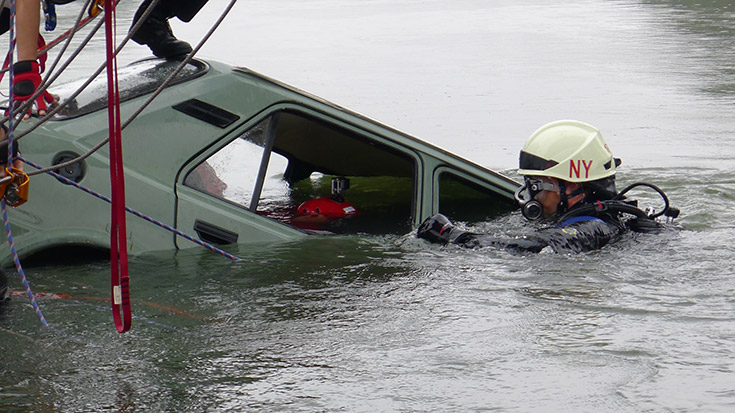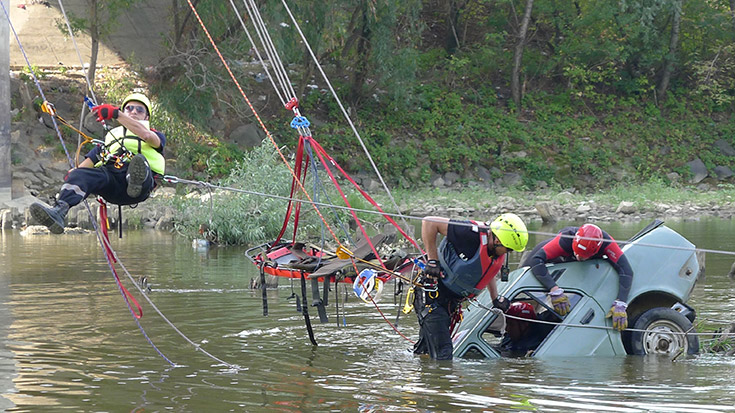Water rescue exercise
Editorial Advisory Panel Member Christo Motz has been back to the north-western border region of Romania and Hungary, to advise on the organisation and implementation of the second set of training exercises ( for previous blog).

Project Start is about strengthening cross-border and inter-sectorial operability and financed by the European Commission, and is financed by the European Commission, through the ECHO programme. From Eindhoven I flew to Cluj Napoca, Klausenburg in Romania. From there I drove a rental vehicle to Satu Mare, Sathmar, a trip of about 180 km on winding and poorly lit two-lane roads, taking me over three hours. It was dark when I arrived in the old city centre where I was welcomed by Adam Boer and his family. Adam works as an Alpine rescue worker for Multisalva.
The co-operation between Romanian and Hungarian first responders is based on a joint intervention plan wherein it should be clear what the capabilities, as well as the expectations are. Initially it was started for firefighting. Last June it was already clear to me that the centrally-led organisational structures in Bucharest and Budapest were obstacles. In the meantime a co-operation agreement has been signed; an important step forward.
It is essential for the local authorities to have a bigger say on the implementation of trans-boundary emergency response in the case of a disaster in this region, but no agreement has, as yet, been reached on this matter. If this is not realised, emergency responders will encounter problems with regard to trans-boundary response repeatedly in future disasters and emergencies.
The decentralised structure that is now deployed was developed by the EU. This model includes collaboration on a local level, which may sound contradictory. It is a long-term project that is being integrated and implemented along the whole length of the Szamos/Somes river.
An operational deployment of three teams which have been trained in advance in protocol, technical and legal aspects and are then integrated into the existing emergency response structure should be able to tackle most problems quickly, cost-efficiently and effective; however that level has not been reached yet.
This latest exercise the exercise took place on the bridge across the Szomes that connects both parts of Satu Mare city. A specially prepared car was lowered to a depth of about 15 metres in the centre of the river. Two divers from Multisalva, Special Rescue Team seated themselves inside. In this scenario the only possible rescue effort would be from the bridge.
Szabolcs Fülöp, director of Multisalva and organiser of this training, had prepared everything in great detail. However the evening before the training, the crane operator had failed to appear and it was unclear whether another crane operator and tow truck would be found. Luckily, one was sourced early the next day. The police also arrived a little later than expected. But after arriving they closed off a large part of the road, ensuring the safety of the participants.
The convoy started late. There were many spectators. From a distance the sirens of oncoming fire trucks and the emergency response team Smurd could be heard. The troops stepped out and assumed their positions. Numerous press photographers and camera crews were doing live reports of this exercise.
The first rescue team descended to the vehicle, and divers saved another victim from the water. This phase tested procedures and practised high angle rescue techniques.
The weather was sunny and warm, almost 30°C. During a winter storm there would be much less time to get an overview and act effectively, therefore it was good to be able to practise together under these ideal circumstances.
Lessons learned
The exercise went well thanks to the dedication and professionalism of all participants. The recommendations of the previous exercises in June had been integrated where possible. More attention will be paid to the joint after-action review. This is essential to realise commitment of all participating organisations. Once there is an understanding about the difficulties that other parties encounter, and it becomes clear that ignorance has consequences, the deployability and effectiveness of first responders will improve.
A point of attention is the long preparation time of the rescue teams. It took 30 minutes before the first responders reached the vehicle in the water. One of the victims was pronounced ‘dead’.
It really is realistic training when the living ‘dead’ person purposely becomes slack while hoisted up, bending the backbone in a dangerous curve. It is not clear to me why the ‘deceased’ is not lifted out on a gurney. Health and Safety standards can still be improved here.
It is easy to judge. I realise how much work and energy it takes to set up a complex multi-disciplinary training exercise. This is especially challenging when trans-boundary co-operation has only just begun and there are many parties involved, each with their own traditions and work culture. It takes perseverance and clear vision to reach a satisfactory end result. These are the qualities that Zsolt Csengeri of Agenda Setting and Zsabolcs Fülöp have fully developed.
The training was finalised with a communal lunch in the basement of the Satu Mare town hall. This concrete bunker tower dominates the old city and is a remnant from Ceausescu’s time.
The following day, the same the same scenario was deployed, but in Vásárosnamény, about 60 km west of Satu Mare, where the Szamos and Tisza rivers join.
I drove to the Hungarian border with my client, Zsabolcs Fülöp. There was a long line of cars and trucks subjected to increased checks at the Romanian-Hungarian border as border patrol was searching for potential stowaways. In the Communist era of Ceausescu waiting time could be up to eight hours before you could cross the border. Now we only had to wait 20 minutes before being able to continue our journey.
Nightfall came quickly and we drove about 60 kilometres in the dark on poorly maintained two-lane roads winding through dimly lit villages which all seemed to have a statue our group of statues in the main square symbolising the heroic martial history of Hungary. This is the region of the Pusztas, vast planes and farmlands with but a few simple barns.

In reality the previous day’s exercise was a repeat of the day before, although the conditions had changed. It was cooler the day before and the Tisza/Szamos river flow was higher, the river here was a few metres deep and required a different approach.
The Hungarian Fire brigade and Katastrophenschutz arrived early to be able to roll out the same scenario with the Romanian first responders. It mainly requires a lot of manpower, good communication skills and co-operation between the troops on the riverbanks, in the water and on the bridge.
There were three men in the water; one was rescued by first responders on a rigid inflatable boat.
Another team of responders descended from the 20-metre high bridge to the crashed vehicle. A diver entered the river and performed the first rescue manoeuvre.
The high angle rescue team placed the patient in the stretcher and hoisted him up to the bridge. A little later a drowned person was salvaged from the wreckage and brought to the surface.
An obvious hazard in case of an accident involving water is drowning. In most cases the first responders do not get to the site on time and the vehicle occupants do not survive, unless they manage to extricate themselves from the vehicle are helped to do so by bystanders.
But that would be quite a feat. When you hit the water at (high) speed (from a height/in the dark) with a vehicle it depends on the speed, the nature of the accident, the type of vehicle and your physical and mental state whether you are even able to survive such an accident. If you are trapped and/or unresponsive the survival rate is zero.
You need to be able to save yourself. For instance by keeping a ‘safety hammer’ within reach, and more importantly, have practised using it. If there are more passengers in the vehicle it is important they can make their escape through an open window. By holding onto the doorjamb on the outside an underwater rescue can take place should anyone have been left behind. Training in escape from vehicles in water is highly recommended.
Another major problem is the quick onset of hypothermia. In flowing water humans lose their body heat 25 times faster than when exposed to open air. In case of trauma including (serious) loss of blood, a patient will lose his or body heat even faster and it will have an adverse affect on the coagulation of the blood. Handling of an unresponsive (near-) drowning patient can lead to circulatory arrest.
Upon my request conducted a post-exercise evaluation, providing first responders, officers and soldiers a chance to share their experiences with each other. This is, as stated previously, a fundamental and crucial part of the process to come to co-operation and integration of the various disciplines. This approach was much appreciated by the men and the outcome was heart warming. This exercise also highlighted the complexity of command and control as well as technical assistance. There has been good progress but there is still a way to go.
Early the next morning I left the centre of Satu Mare in Romania and headed for Cluj Napoca, Klausenburg, from where I was flying back home. It had been raining relentlessly all day, and I needed to stay alert while driving.
En route I passed two farmers with a herd of cows taking up the whole road. Then I passed a farmer on a horse-drawn cart and a group of brightly coloured gypsies who suddenly crossed the road. In a hilly part at one point, an ambulance overtook me at great speed.
About ten minutes later I entered a village and saw the blue glare of flashing lights reflected against the houses. There was a person lying in the middle of the street in the pouring rain, covered by a tarpaulin with only feet sticking out. About 15 metres further down I saw a truck with its hazard lights on. Policemen and paramedics huddled in the rain conferring. Dismayed bystanders gawked at the scene from a distance.
Following the directions of a police officer I drove around the scene of the accident and considered again the madness of the crazy traffic. Everyone in Romania drives as if they have a death wish. Once in Cluj I saw the remains of a truck with trailer that had just cut straight through a roundabout and crashed into a wall. The truck’s cabin was completely destroyed. I doubt much was left of the driver as well.
All the way, I kept reminding myself to stay attentive.
NOTE: Road risk is a global problem of ‘epidemic’ scale, according to the World Health Organisation. Currently the ninth leading cause of death worldwide, with 1.25 million lives lost a year, road crashes kill more people than malaria and have nearly reached the global fatality levels of tuberculosis. In the next issue of CRJ, Emma MacLennan looks at some initiatives that the donor community is taking to address this problem.
Christo Motz, 26/11/2015